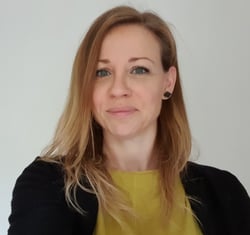Unlocking geospatial data: Giving space to the power of place
Geospatial data goes beyond just maps and apps. The power of location data underpins solutions to climate change and energy, while boosting national resilience and economic growth. Despite this, there remains limited awareness of the full value of geospatial applications.
Three senior experts from the Ordnance Survey (OS), The Office for National Statistics (ONS) and the Ministry of Defence (MoD) share how they are demonstrating the value of geospatial data and building new use cases to maximise its impact.
Going mainstream
“We’ve seen a boom in location data in the last five to ten years, with a democratisation and trivialisation of it through the use of applications such as Google map, Uber and Deliveroo – all thanks to the mainstream use of mobile phones,” says Olive Powell, Head of geospatial data at ONS.
The insight provided by geospatial data during the pandemic also highlighted its relevance, not just for health planning but overall national resilience. “Its added value, compared to traditional data, has led to fast growth in both interest and demand,” Powell notes.
relevance, not just for health planning but overall national resilience. “Its added value, compared to traditional data, has led to fast growth in both interest and demand,” Powell notes.
David Henderson, Chief Geospatial Officer at OS, says the establishment of the Geospatial Commission within the Cabinet Office in 2018 – an independent committee of experts – has made great strides in promoting the value of location data. It recently published its 2030 strategy, which includes a drive to increase the adoption of enabling technologies, greater use of geospatial applications and insights across the economy and measures to build confidence in the future geospatial ecosystem.
They also set out an ambition to host an international geospatial conference in 2024. “We are recognised for our proven world-leading expertise in location data and our approach in supporting and advising partners across Great Britain and the globe. As a Government, we should be really proud of having one of the best developed geospatial infrastructures,” Henderson says.
Awareness, appreciation and accessibility
There remains, however, a limited awareness of the use of geospatial data among non-specialists, Powell notes. “I think location data is either misunderstood or taken for granted – and it’s down to a historic inability to promote and quantify its benefits.”
She argues that for this reason cross-government data processes have not caught up with the times, with geospatial data use remaining “sporadic” and “still isolated to more expert groups.”
There is still a widespread belief that location data is onerous and complicated. In his role advising senior leaders on spatially-related situations and solutions, Major George McCrea, Senior Product Owner of the Defence Data and Analytics Platform at the MoD’s Defence Digital Foundry, talks about the idea of the ‘unconscious geographer’. He says everyone has an inherent understanding of location - it’s just a matter of waking them up to it. “It’s important that we, as geospatial leaders, demystify the process and show people how easy it can be; building awareness, trust and appreciation through a range of use cases is key to unlocking its full potential.”
Like McCrea, Henderson highlights geospatial’s reputation for being highly technical and “a little bit misunderstood”. He says OS, as a trusted provider of accurate location data, is always working to ensure its data is more easily accessible by non-specialists – most recently through the launch of its National Geospatial database - a single store of all its data for Great Britain.
“This makes it easier to find, package and analyse OS data, including address, roads and building information. It’s a big step in anchoring location data in the mainstream data industry, and we’re now seeing our data combined with economic datasets from the likes of Companies House and environment data from Defra,” Henderson says. “OS geospatial data is already an integral component of the nation’s data ecosystem, helping to support vital public services, but today it also plays a unifying role between our increasingly interconnected digital infrastructure and the real world. That’s the challenge and the opportunity of geospatial data.”
There is still a need to boost collective geospatial capabilities, Henderson adds. This is why OS and ONS have collaborated to deliver an ‘Introduction to Geospatial Data’ across government, covering areas from access and acquisition through to data visualisation and practical application. Joining the programme were participants from departments including HM Land Registry, HM Revenue and Customs, Ministry of Defence, and Welsh Government.
Powell highlights the practical benefits of bringing geospatial thinking to the forefront of data science. Left as an after-thought, it can become a hindrance to effective use of data, she warns. “If not designed at the start, collecting and processing geospatial data is quite time consuming. Sometimes, we cannot answer some policy questions because information is not captured at geographically granular level enough.”
She emphasises the need to pull expertise from all sectors to better articulate what geospatial can do. “There is an impetus on people like me to evangelise geospatial, constantly being interested with what others do with geospatial data, to find those great examples and use cases that can be shared to leaders and decision-makers. This involves a deep understanding of geospatial but also an ability to understand various applications in many sectors.“
Gone are the days where geospatial data was used just for environment monitoring, Powell adds. “It now affects everything so we need to pull expertise from all sectors and industries to articulate what geospatial data can offer better.”
 McCrea notes that “spreading the knowledge” by bringing a broad range of geospatial communities together is an important step in diversifying spatial services and applications. He delivered NATO’s multinational geospatial training event, its biggest exercise for people to build interoperability skills from geo-professionals across 21 different nations. “Every country does this in a slightly different way so it’s really important that we understand what each other brings to the party to get that full spectrum of diversity.”
McCrea notes that “spreading the knowledge” by bringing a broad range of geospatial communities together is an important step in diversifying spatial services and applications. He delivered NATO’s multinational geospatial training event, its biggest exercise for people to build interoperability skills from geo-professionals across 21 different nations. “Every country does this in a slightly different way so it’s really important that we understand what each other brings to the party to get that full spectrum of diversity.”
Levelling up location data
With ever more complex issues to solve and advances in technology that are rapidly transforming geospatial ecosystems, there has been a greater focus on the integration of data assets. “Data from a single source is no longer enough,” Powell explains. “I believe “geography” is a common language that enables the integration of information from various sources. This obviously means that “geography” needs to be at the forefront of data collection and embedded within all other datasets.”
Having a strong national spatial data infrastructure and geo-enabled data architecture supporting this would not only enable better and faster data analyses, but it would also enable far greater insights to arising issues and problems to solve, Powell says.
There’s an increasing need for collaboration and data sharing between organisations and government departments. Powell says a “system of systems” is now being discussed, like the Geospatial Knowledge Infrastructure. This is a concept led by the UN in partnership with Geospatial World and organisations like Ordnance Survey, where technology allows for data to flow within various geospatial ecosystems, providing the opportunity to pull disparate datasets together in a single context to produce a bigger picture.
In the spirit of greater collaboration, Powell says ONS is engaging with OS to foster an even closer relationship, with a view to better combine their geospatial data provisions and add value to each other’s data remit – physical geography for OS and human geography for ONS. “What we want to do is consolidate the UK geospatial data offer between our national two mapping and statistical agencies in order to benefit government bodies and other customers throughout the UK to make better use of our datasets in order to answer those critical and emerging policy questions of the time and enable better decision making,” she says.
The future of geospatial
A key trend shaping the geospatial ecosystem is the enrichment of data. OS recently released a new series of mapping data products delivering greater accuracy and details to buildings and transport features in Great Britain; new data which is available through the OS National Geographic Database. As Henderson explains: “It’s not enough to tell someone there’s a building, they want to know what the make-up of that building is, the age, the roof type and the composition. This is essential information delivering layers of insight for better decision-making for many of the customers we work with.”
The ability to derive deeper, more meaningful insights using location data can lead to more effective and progressive policies, Henderson says. “It will also play a particularly important role in influencing conversations about green infrastructure and getting to Net Zero. OS has been a key partner in a number of projects focusing on the role of geospatial in monitoring changes to the environment. These have included the development of a water pollution predictive tool as well as a heat map using satellite data analysis to support resilience planning and to understand those environmental changes.
also play a particularly important role in influencing conversations about green infrastructure and getting to Net Zero. OS has been a key partner in a number of projects focusing on the role of geospatial in monitoring changes to the environment. These have included the development of a water pollution predictive tool as well as a heat map using satellite data analysis to support resilience planning and to understand those environmental changes.
“The impact of climate of change is just one of several challenges facing society and we shouldn’t underestimate the role which authoritative and trusted location data can play. Accurate location data is also the digital fuel to help enable emerging technologies and markets – from future digital twins to connected autonomous vehicles, the power of place has never been so important.”
The increasing availability of faster data sources, such as earth observations and mobility data, is unlocking the potential to analyse and understand issues previously considered too complex, building new use cases and demonstrating the value of geospatial data, Powell says. “This may be in the form of new datasets, more accurate datasets or new technology advancement enabling the exploitation of these datasets (e.g. 4D representation). I am sure there will be some very clever people out there that will come up with the next generation of geospatial datasets that will blow our minds.”
Also commenting on the future of geospatial, McCrea says: “We have got to stop being afraid of looking at problems because they are too complicated. There is a lot of that happening in the world right now – but most challenges either have an understanding or a solution that can be partly derived from geospatial data.
“The question is how can we properly use geospatial to help the solutions along the way. It’s not necessarily the be all and end all, but it’s a fantastic solution to understanding how to go forward.”

By Sam Birchall
Sam is the senior reporter at Government Transformation Magazine.Also Read
- Introducing new technologies: best practices and pitfalls to avoid
- Transforming public service delivery: AI, automation and trust in the modern Civil Service
- New research reveals how AI could reinvent UK public services
- Data sharing can improve government services and save lives. So why aren’t we doing it?




.png?width=600&name=GovX%20Show%20title%20NEW%20(1).png)